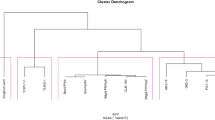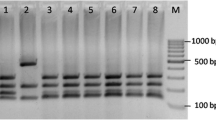Abstract
Several indigenous Saccharomyces strains from musts were isolated in the Jerez de la Frontera region, at the end of spontaneous fermentation, in order to select the most suitable autochthonous yeast starter, during the 2007 vintage. Five strains were chosen for their oenological abilities and fermentative kinetics to elaborate a Sherry base wine. The selected autochthonous strains were characterized by molecular methods: electrophoretic karyotype and random amplified polymorphic DNA-polymerase chain reaction (RAPD-PCR) and by physiological parameters: fermentative power, ethanol production, sugar consumption, acidity and volatile compound production, sensory quality, killer phenotype, desiccation, and sulphur dioxide tolerance. Laboratory- and pilot-scale fermentations were conducted with those autochthonous strains. One of them, named J4, was finally selected over all others for industrial fermentations. The J4 strain, which possesses exceptional fermentative properties and oenological qualities, prevails in industrial fermentations, and becomes the principal biological agent responsible for winemaking. Sherry base wine, industrially manufactured by means of the J4 strain, was analyzed, yielding, together with its sensory qualities, final average values of 0.9 g/l sugar content, 13.4 % (v/v) ethanol content and 0.26 g/l volatile acidity content; apart from a high acetaldehyde production, responsible for the distinctive aroma of “Fino”. This base wine was selected for “Fino” Sherry elaboration and so it was fortified; it is at present being subjected to biological aging by the so-called “flor” yeasts. The “flor” velum formed so far is very high quality. To the best of our knowledge, this is the first study covering from laboratory to industrial scale of characterization and selection of autochthonous starter intended for alcoholic fermentation in Sherry base wines. Since the 2010 vintage, the indigenous J4 strain is employed to industrially manufacture a homogeneous, exceptional Sherry base wine for “Fino” Sherry production.



Similar content being viewed by others
References
Angeles Pozo-Bayon M, Victoria Moreno-Arribas M (2011) Sherry wines. Adv Food Nutr Res 63:17–40
Aranda A, del Olmo M (2003) Response to acetaldehyde stress in the yeast Saccharomyces cerevisiae involves a strain-dependent regulation of several ALD genes and is mediated by the general stress response pathway. Yeast 20:747–759
Barnett JA, Payne RW, Yarrow D (1990) Yeast: characteristics and identification, 2nd edn. Cambridge University Press, England
Barrales RR, Jiménez J, Ibeas JI (2008) Identification of novel activation mechanisms for FLO11 regulation in Saccharomyces cerevisiae. Genetics 178:145–156
Benítez T, Rincón AM, Codón AC (2011) Yeasts used in biologically aged wines. In: Carrascosa AV, Munoz D, González R (eds) Molecular wine microbiology. Elsevier, San Diego p 51–84
Boyd AR, Gunasekera TS, Attfield PV, Simic K, Vincent SF, Veal DA (2003) A flow-cytometric method for determination of yeast viability and cell number in a brewery. FEMS Yeast Res 3:11–16
Budroni M, Giordano G, Pinna G, Farris GA (2000) A genetic study of natural flor strains of Saccharomyces cerevisiae isolated during biological ageing from Sardinian wines. J Appl Microbiol 89:657–662
Capece A, Romaniello R, Siesto G, Pietrafesa R, Massari C, Poeta C, Romano P (2010) Selection of indigenous Saccharomyces cerevisiae strains for Nero d’Avola wine and evaluation of selected starter implantation in pilot fermentation. Int J Food Microbiol 144:187–192
Casalta E, Aguera E, Picou C, Rodriguez-Bencomo JJ, Salmon JM, Sablayrolles JM (2010) A comparison of laboratory and pilot-scale fermentations in winemaking conditions. Appl Microbiol Biotechnol 87:1665–1673
Codón AC, Benítez T, Korhola M (1998) Chromosomal polymorphism and adaptation to specific industrial environments of Saccharomyces strains. Appl Microbiol Biotechnol 49:154–163
Charpentier C, Colin A, Alais A, Legras JL (2009) French Jura flor yeasts: genotype and technological diversity. Antonie Van Leeuwenhoek 95:263–273
Chovanova K, Krakova L, Zenisova K, Turcovska V, Brezna B, Kuchta T, Pangallo D (2011) Selection and identification of autochthonous yeasts in Slovakian wine samples using a rapid and reliable three-step approach. Lett Appl Microbiol 53:231–237
De Benedictis M, Bleve G, Grieco F, Tristezza M, Tufariello M, Grieco F (2010) An optimized procedure for the enological selection of non-Saccharomyces starter cultures. Antonie Van Leeuwenhoek 99:189–200
Espinazo-Romeu M, Cantoral JM, Matallana E, Aranda A (2008) Btn2p is involved in ethanol tolerance and biofilm formation in flor yeast. FEMS Yeast Res 8:1127–1136
Esteve-Zarzoso B, Fernandez-Espinar MT, Querol A (2004) Authentication and identification of Saccharomyces cerevisiae ‘flor’ yeast races involved in sherry ageing. Antonie Van Leeuwenhoek 85:151–158
Esteve-Zarzoso B, Peris-Torán MJ, García-Maiquez E, Uruburu F, Querol A (2001) Yeast population dynamics during the fermentation and biological aging of sherry wines. Appl Environ Microbiol 67:2056–2061
Fleet GH (2008) Wine yeasts for the future. FEMS Yeast Res 8:979–995
Ibeas JI, Lozano I, Perdigones F, Jiménez J (1997) Dynamics of flor yeast populations during the biological aging of Sherry wines. Am J Enol Vitic 48:75–79
Ishigami M, Nakagawa Y, Hayakawa M, Iimura Y (2006) FLO11 is the primary factor in flor formation caused by cell surface hydrophobicity in wild-type flor yeast. Biosci Biotechnol Biochem 70:660–666
Lopes CA, Rodriguez ME, Sangorrin M, Querol A, Caballero AC (2007) Patagonian wines: implantation of an indigenous strain of Saccharomyces cerevisiae in fermentations conducted in traditional and modern cellars. J Ind Microbiol Biotechnol 34:139–149
Lopes CA, Rodríguez ME, Sangorrin M, Querol A, Caballero AC (2007) Patagonian wines: the selection of an indigenous yeast starter. J Ind Microbiol Biotechnol 34:539–546
Martinez P, Codón AC, Perez L, Benítez T (1995) Physiological and molecular characterization of flor yeasts: polymorphism of flor yeast populations. Yeast 11:1399–1411
Martínez P, Pérez L, Benítez T (1997) Evolution of flor yeast population during the biological aging of fino sherry wine. Am J Enol Vitic 48:160–168
Martínez P, Pérez L, Benítez T (1997) Factors which affect velum formation by flor yeast isolated from sherry wine. Syst Appl Microbiol 20:154–157
Martínez P, Pérez L, Benítez T (1997) Velum formation by flor yeasts isolated from sherry wine. Am J Enol Vitic 48:55–62
Martínez P, Valcárcel MJ, Pérez L, Benítez T (1998) Metabolism of Saccharomyces cerevisiae flor yeasts during fermentation and biological aging of fino sherry: by-products and aroma compounds. Am J Enol Vitic 49:240–250
Mesa JJ, Infante JJ, Rebordinos L, Cantoral JM (1999) Characterization of yeasts involved in the aging of sherry wines. Food Sci Technol 32:114–120
Muñoz D, Peinado RA, Medina M, Moreno J (2005) Biological aging of sherry wines using pure cultures of two flor yeast strains under controlled microaeration. J Agric Food Chem 53:5258–5264
Nelson NJ (1955) Colorimetric analysis of sugars. Methods Enzymol 3:85–86
OIV (1990) Recueil des Methodes Internationales d’Analysis des Vins et des Mouts. Office Internationale Vigne Vin, Paris
Peinado RA, Moreno J, Medina M, Mauricio JC (2004) Changes in volatile compounds and aromatic series in sherry wine with high gluconic acid levels subjected to aging by submerged flor yeast cultures. Biotechnol Lett 26:757–762
Pulvirenti A, Rainieri S, Boveri S, Giudici P (2009) Optimizing the selection process of yeast starter cultures by preselecting strains dominating spontaneous fermentations. Can J Microbiol 55:326–332
Rodríguez ME, Infante JJ, Molina M, Domínguez M, Rebordinos L, Cantoral JM (2010) Genomic characterization and selection of wine yeast to conduct industrial fermentations of a white wine produced in a SW Spain winery. J Appl Microbiol 108:1292–1302
Romano P, Fiore C, Paraggio M, Caruso M, Capece A (2003) Function of yeast species and strains in wine flavour. Int J Food Microbiol 86:169–180
Settanni L, Sannino C, Francesca N, Guarcello R, Moschetti G (2012) Yeast ecology of vineyards within Marsala wine area (western Sicily) in two consecutive vintages and selection of autochthonous Saccharomyces cerevisiae strains. J Biosci Bioeng 114:606–614
Somogyi M (1952) Note on sugar determination. J Biol Chem 195:19–25
Suárez-Lepe JA (1997) Levaduras vínicas: funcionalidad y uso en bodegas. Ediciones Mundi-Prensa, Madrid
Suárez-Lepe JA, Íñigo Leal B (2004) Microbiología enológica. Fundamentos de vinificación, 3rd edn. Ediciones Mundi-Prensa, Madrid
Suzzi G, Schirone M, Sergi M, Marianella RM, Fasoli G, Aguzzi I, Tofalo R (2012) Multistarter from organic viticulture for red wine Montepulciano d’Abruzzo production. Front Microbiol 3:135
Takagi H, Sakai K, Morida K, Nakamori S (2000) Proline accumulation by mutation or disruption of the proline oxidase gene improves resistance to freezing and desiccation stresses in Saccharomyces cerevisiae. FEMS Microbiol Lett 184:103–108
Teresa Fernández-Espinar M, Barrio E, Querol A (2003) Analysis of the genetic variability in the species of the Saccharomyces sensu stricto complex. Yeast 20:1213–1226
Torrens J, Urpi P, Riu-Aumatell M, Vichi S, López-Tamames E, Buxaderas S (2008) Different commercial yeast strains affecting the volatile and sensory profile of cava base wine. Int J Food Microbiol 124:48–57
Tristezza M, Vetrano C, Bleve G, Grieco F, Tufariello M, Quarta A, Mita G, Spano G, Grieco F (2012) Autochthonous fermentation starters for the industrial production of Negroamaro wines. J Ind Microbiol Biotechnol 39:81–92
Xufre A, Albergaria H, Girio F, Spencer-Martins I (2010) Use of interdelta polymorphisms of Saccharomyces cerevisiae strains to monitor population evolution during wine fermentation. J Ind Microbiol Biotechnol 38:127–132
Zara G, Zara S, Pinna C, Marceddu S, Budroni M (2009) FLO11 gene length and transcriptional level affect biofilm-forming ability of wild flor strains of Saccharomyces cerevisiae. Microbiology 155:3838–3846
Acknowledgments
This research was supported by CICYT projects AGL2006-03947, TRACE PET2008_0283, and Junta de Andalucía (PAI CVI-107 PO6-CVI-01546). There was financial support from Beam Global-Jerez de la Frontera (OG-127/06, OG-185/07). The authors thank the cellar and laboratory staff at Beam Global España S. L. for their kind help; they also thank A. M. Rincón for useful criticism.
Author information
Authors and Affiliations
Corresponding author
Rights and permissions
About this article
Cite this article
Rodríguez-Palero, M.J., Fierro-Risco, J., Codón, A.C. et al. Selection of an autochthonous Saccharomyces strain starter for alcoholic fermentation of Sherry base wines. J Ind Microbiol Biotechnol 40, 613–623 (2013). https://doi.org/10.1007/s10295-013-1251-0
Received:
Accepted:
Published:
Issue Date:
DOI: https://doi.org/10.1007/s10295-013-1251-0




